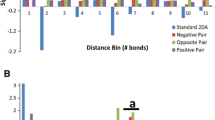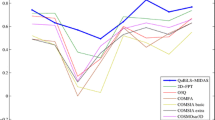Abstract
The electron-conformational (EC) method in QSAR problems employs a unique (based on first principles) descriptor of molecular properties that incorporates the electronic structure and topology of the molecule and is presented in a digital-matrix form suitable for computer processing, the EC matrix of congruity (ECMC). Its matrix elements have clear-cut physical meanings of interatomic distances, bond orders, and atomic reactivity (interaction indices). By comparing these matrices for several active compounds of the training set a group of matrix elements is revealed that are common for these compounds within a minimum tolerance, the EC submatrix of activity (ECSA). The latter is the numerical pharmacophore for the level of activity and diversity of the tried compounds. The EC method was described in detail and used for pharmacophore identification and quantitative bioactivity prediction elsewhere. In this paper we give further general considerations of its uniqueness and emphasize its advantages as compared with traditional QSAR methods, outlining the following three novel points: (1) The unique, non-arbitrary descriptor employed in the EC method avoids the shortcomings of the arbitrary chosen descriptors and statistical estimation of their weight in the evaluation of the pharmacophore used in traditional QSAR methods. Arbitrary descriptors may be interdependent (“non-orthogonal”) and their sets are necessarily incomplete, hence they may lead to chance correlations and artifacts. The EC pharmacophore is void of these failures, thus deemed to be absolutely reliable within the accuracy of the experimental data and the diversity of the molecules used in its evaluation; (2) The tolerances in the matrix elements of the ECSA play a special role reflecting the flexibilities of the pharmacophore parameters and the dependence of the activity on the latter quantitatively; they are obtained in a minimization procedure; by increasing the tolerances one can get pharmacophores for larger intervals of activity. An advanced formula is derived for the activity as a function of the drug–receptor bonding energy which handles also the multi-conformational problem, and a regressional procedure is suggested to represent the interaction energy and the activity by the ECSA matrix elements or tolerances; (3) The possibility of bimolecular activity is discussed when a single molecule of the active compound has no pharmacophore, but the latter is present in the bimolecular structure. Examples are given from the problem of aquatic toxicity to fish.





Similar content being viewed by others
References
Kubinyi H, Folkers G, Martin YC (2002) 3D QSAR in drug design. Volume 3, Recent advances. Kluwer Academic Publishers, New York
Marshall GR (1995) In: Wolff ME (ed) Burger’s medicinal chemistry and drug discovery: principles and practice, 5th ed., vol. 1, Wiley, New York, pp 573–659
Bersuker IB (1996) Electronic structure and properties of coordination compounds. Introduction to the theory. Wiley, New York, pp xxiv + 668
Bersuker IB (2003) Pharmacophore identification and quantitative bioactivity prediction by the electron-conformational method. Curr Pharm Des 9:1575–1606
Bersuker IB, Bahceci S, Boggs JE (2000) The electron-conformational method of identification of pharmacophore and anti-pharmacophore shielding In: Guner OF (ed) Pharmacophore perception, development, and use in drug design. International University Line, La Jolla, pp 455–476
Bersuker IB, Bahceci S, Boggs JE (2000) Improved electron-conformational method of pharmacophore identification and bioactivity prediction. Application to angiotensin-converting enzyme inhibitors. J Chem Inf Comp Sci 40:1363–1376
Gorinchoy NN, Ogurtsov IYa, Tihonovschi A, Balan I, Bersuker IB, Marenich A, Boggs JE, Toxicophore and quantitative structure–toxicity relationships for some environmental pollutants. Chem J Moldova (in press)
Bersuker IB, Bahceci S, Boggs JE, Pearlman RS (1999) An electron-conformational method of identification of pharmacophore and anti-pharmacophore shielding. Application to rice blast activity. J Comp-Aided Mol Des 13:419–434
Bersuker IB, Dimoglo AS, Gorbachov MYu, Vlad PF, Pesaro M (1991) Origin of musk fragrance activity. The elecron-topologic approach. New J Chem 15:307–320
Shultz AR (1994) Enzyme kinetics. Cambridge University Press, Cambridge
Author information
Authors and Affiliations
Corresponding author
Rights and permissions
About this article
Cite this article
Bersuker, I.B. QSAR without arbitrary descriptors: the electron-conformational method . J Comput Aided Mol Des 22, 423–430 (2008). https://doi.org/10.1007/s10822-008-9191-x
Received:
Accepted:
Published:
Issue Date:
DOI: https://doi.org/10.1007/s10822-008-9191-x




